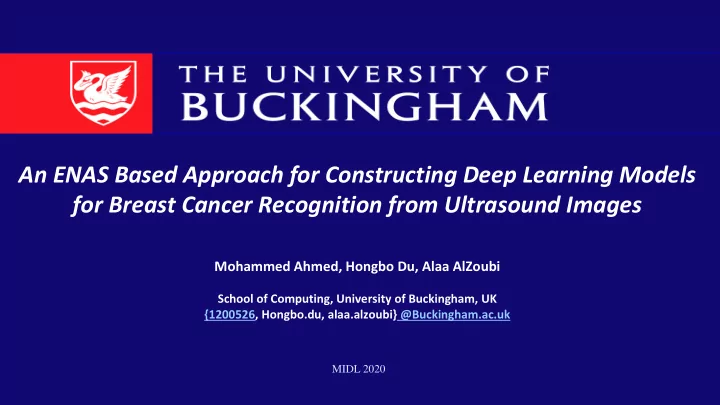

An ENAS Based Approach for Constructing Deep Learning Models for Breast Cancer Recognition from Ultrasound Images Mohammed Ahmed, Hongbo Du, Alaa AlZoubi School of Computing, University of Buckingham, UK {1200526, Hongbo.du, alaa.alzoubi} @Buckingham.ac.uk MIDL 2020
Introduction Background • Widespread use of handcrafted CNN architectures (AlexNet, VGGNet, GoogLeNet ,ResNet …etc.) Framework of NAS technique • CNN architectures: hard to design • Recent Development: automatic architecture search ▪ Neural Architecture Search (NAS) ▪ Efficient Neural Architecture Search (ENAS) Aim of the Study To Investigate effectiveness of ENAS for breast cancer recognition from US images 2 MIDL 2020
Methods Hyperparameter setting for final CNN Model: Hyperparameter setting for Searching: • Batch size = 8 • Batch size = 8 • No. of epochs =100 Image size =100 100 • Image size =100 100 • • Other hyperparameter settings: the default • Other hyperparameter settings: the default values of ENAS values of ENAS Layers in final architectures: • ENAS 17 (5*N, R, 5*N, R, 5*N) • ENAS 7 (N, R, N, R, 3*N) Optimal cells(Norman and Reduction) generated by ENAS for Breast Cancer classification 3 MIDL 2020
Data and Results Dataset • Ultrasound images for breast lesions (262 Benign and 262 Malignant images) • Different US machine makes Examples of ultrasound images with labeled region of interest Data Preparation • Manual cropping of RoI by radiologist ENAS Models Performance and Comparison with Models of Other Architectures • Training data augmentation: Models TNR TPR PR Accuracy #Parameters ▪ Geometric Methods: Rotation (90,180 and ENAS 17 86.7% 92.0% 87.5% 89.3% 4,251,780 270), and Mirroring ENAS 7 90.9% 86.7% 91.0% 88.8% 2,342,484 ▪ Singular Value Decomposition (SVD) (25, 35 AlexNet 51.6% 48.5% 50.0% 50.0% 56,858,656 and 45) CNN3 [1] 80.5% 75.6% 84.0% 78.1% 619,202 • Bicubic Resizing (100 100) 4 MIDL 2020
Concluding Remarks • Conclusion : ▪ Investigated the efficacy of the ENAS approach for designing CNN architectures for breast lesion classification from US. ▪ Demonstrated that the ENAS technique reduces human interventions in CNN architecture design. ▪ The optimized architectures lead to more accurate classification yet simpler models than hand- crafted alternatives for breast lesion classification . • Future work: ▪ Evaluating ENAS models on external datasets ▪ Exploiting ENAS architectures for other types of tumors/lesions from ultrasound images MIDL 2020 5
Recommend
More recommend